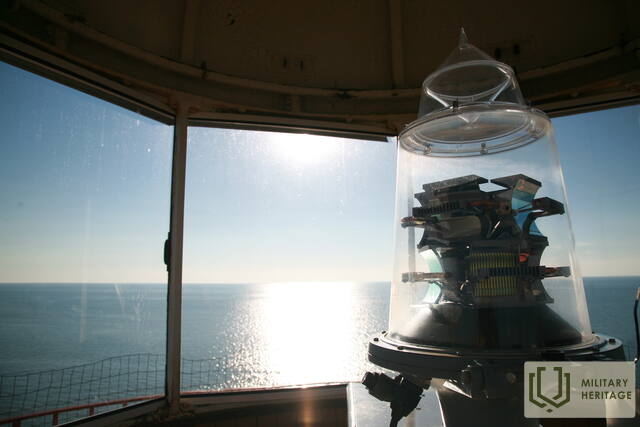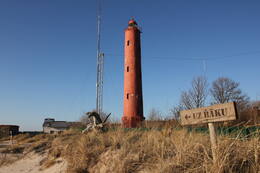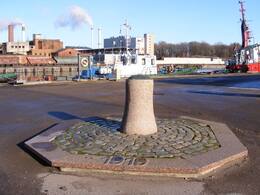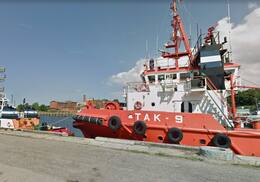Kyšulys ir laivas „Saratovas“
Galima manyti, kad Liepoja trumpą laiką buvo Latvijos sostinė, nes Laisvės kovų metu Laikinoji vyriausybė buvo dislokuota laive „Saratov“ būtent šiame mieste. „Saratov“ po Rygos išlaisvinimo Laikinąją vyriausybę nugabeno į ją, tačiau daugelis žmonių nežino, kad tokio svarbaus mums laivo istorija baigėsi jūroje, Akmenrage.
Plačiausiai žinomas laivas, užplaukęs ant uolėto Akmeņrago seklumos ir ten išbuvęs amžinai, yra garlaivis „Saratov“. Šis laivas yra istoriškai reikšmingas mūsų šaliai, nes Nepriklausomybės karo metu jame buvo Latvijos laikinoji vyriausybė, vadovaujama Kārlio Ulmanio, ir būtent šis laivas nuplukdė Laikinąją vyriausybę į išlaisvintą Rygą.
„Saratov“ buvo pastatytas Danijoje 1888 m. ir iš pradžių plaukiojo pavadinimu „Leopold II“. 1911 m. laivą įsigijo Rusijos Šiaurės vakarų laivybos kompanija ir pervadino jį į „Saratov“. Laivo namų uostas buvo Liepoja, iš kur jis reguliariai plaukiodavo į Didžiąją Britaniją. Pirmojo pasaulinio karo metu laivas kelis kartus keitė savininkus, kol po taikos sutarties pasirašymo Latvija jį grąžino SSRS. Paskutinės kelionės metu laivas plaukė į Didžiąją Britaniją, tačiau pakeliui turėjo sustoti Liepojoje, kad išlaipintų Latvijos jūreivius. Laivui jau vadovavo sovietų įgula ir kapitonas, Latvijos jūreiviai buvo tik keleiviai.
1923 m. sausio 14 d. Paviluosto žvejai pamatė nuo kranto garlaivį, plaukiantį Liepojos link, tačiau šis plaukia per arti kranto. Žvejai vis dar mano, kad jei jie plauks tuo keliu, laivas liks Akmeņrago seklumoje... Laive esantys latvių jūreiviai perspėja vairininką apie pavojų, nes Akmeņrago švyturys jau aiškiai matomas, o jūra tuo metu rami. Vairininkas atsisako keisti laivo kursą be kapitono žinios, tačiau kapitonas tuo metu pietauja. Kai jis pagaliau atvyksta į vairinę, laivo korpusas jau daužosi į seklumos uolas ir jau per vėlu ką nors gelbėti... Iš Liepojos atvyksta gelbėjimo vilkikai, tačiau prasideda audra ir sninga, ir jiems nepavyksta ištraukti laivo nuo seklumos. Kitą rytą Akmeņrago gelbėjimo valčiai, nepaisant audros, pavyksta du kartus išplaukti į jūrą ir išgelbėti laive esančius žmones. Bangos ir audra išlaisvina laivą nuo žemės, tačiau korpuso pažeidimai per dideli ir laivas tiesiog nuskęsta. Dar 1933 m. buvo sakoma, kad laivo kaminas ir stiebai buvo išlindę virš vandens, vėliau laivas buvo iš dalies susprogdintas, o metalas iš jo atsidūrė Liepojos vielos gamykloje. Tačiau ir Akmeņragas gavo savo dalį iš šio laivo, dalis jo nuolaužų vis dar yra jūros dugne. Sakoma, kad laivo vairininkas, grįžęs į SSRS, buvo teisiamas ir nuteistas mirties bausme už šią lemtingą laivo navigacijos klaidą. Apie tolesnę laivo kapitono karjerą informacijos nėra.
Sovietmečiu netoli Akmeņrago švyturio buvo pastatytas ir įrengtas sovietų armijos pasienio apsaugos dalinys.
Žurnalas „Jūreivis“
Susijusi laiko juosta
Susijusios temos
Susijusios vietos
Akmeņrago švyturys ir „Saratovo“ likimas
Akmeņrago švyturys yra Sakos valsčiuje, 10 kilometrų į pietvakarius nuo Paviluostos. Į švyturio viršūnę galima patekti spiraliniais laiptais, iš jos atsiveria vaizdas į jūrą ir aplinkinius miškus. Dabartinis 37 metrų aukščio švyturio bokštas buvo pastatytas 1921 m., o ankstesnis švyturys buvo sunaikintas per Pirmąjį pasaulinį karą.
Akmeņrago švyturys išsiskiria iš kitų Latvijos švyturių, nes yra vienoje pavojingiausių laivybai vietų visoje Baltijos jūros pakrantėje. Švyturio signalinis spindulys žymi uolėtą krantą, kuris šiaurės vakarų kryptimi tęsiasi maždaug dvi jūrmyles arba 3,7 kilometro į jūrą. Kranto gylis yra kiek daugiau nei du metrai. Švyturio vieta nepakito, tačiau pakrantė bėgant metams tolsta. Nors navigacijos šviesa čia yra nuo 1879 m., Akmeņrage įvyko keletas laivų avarijų. Žymiausia įvyko 1923 m. rugsėjį, kai į seklumą atsitrenkė Latvijos garlaivis „Saratow“. 1919 m. Saratovas trumpai buvo Latvijos laikinosios vyriausybės būstinė. Akmeņrage anksčiau buvo pasienio apsaugos postas, čia galima apžiūrėti sovietų armijos pastatus.
Laivo „Saratov“ prieplauka Liepojoje
„Saratov“ prieplauka yra Liepojoje, Senojoje uoste, 59, netoli laivų prieplaukos.
Pastatytas 1888 m. Kopenhagoje laivų statyklos „Buvmeistar & Wain“ pavadinimu „Leopold II“, 1911 m. jį įsigijo akcinė bendrovė „Russian North-West Shipping“ ir pervadino į „Saratov“, o laivo kapitonu tapo latvis Aleksandras Remessas.
1915 m. gegužę, kai Liepoją okupavo vokiečių kariuomenė, laivas „Saratovas“ uoste buvo apgadintas.
1919 m. sausio 10 d. garlaivį „Saratov“ perėmė Latvijos laikinoji vyriausybė. Nuo 1919 m. balandžio iki liepos mėn., po „balandžio 16 d. perversmo“, K. Ulmanio vadovaujama laikinoji vyriausybė buvo „Saratov“ laive ir buvo priversta slėptis sąjungininkų laivyno globoje.
1919 m. liepos 8 d., laikinajai K. Ulmanio vyriausybei perdavus Rygą, garlaiviai buvo naudojami susisiekimui tarp Rygos, Ventspilio ir Liepojos.
Pagal 1920 m. rugpjūčio 11 d. Latvijos ir Sovietų Rusijos taikos sutarties sąlygas garlaivis „Saratovas“ turėjo būti grąžintas Sovietų pusei. 1923 m. sausio 2 d. garlaivis buvo perduotas Sovietų Rusijos atstovui. 1923 m. sausio 15 d. garlaivis „Saratovas“ sudužo prie Akmenrago krantų.
1936 m. Latvijos jūrų departamentas pardavė nuolaužas įmonei, kuri jas sutvarkė ir perdavė Liepojos audinių fabrikui.
Tikroji laivo „Saratov“ švartavimosi vieta
Tikroji laivo „Saratov“ prieplauka yra Liepojoje, Vecā ostmalā 59, netoli laivų prieplaukų, tačiau memorialas yra visai šalia Liepojos specialiosios ekonominės zonos.
Pastatytas 1888 m. Kopenhagoje, laivų statykloje „Buvmeistar & Wain“, pavadinimu „Leopold II“. 1911 m. jį įsigijo Rusijos šiaurės vakarų laivybos kompanija ir pervadino į „Saratov“, o laivo kapitonu tapo latvis Aleksandras Remessas.
1915 m. gegužę, kai Liepoją okupavo vokiečių kariuomenė, laivas „Saratov“ buvo uoste apgadintas.
1919 m. sausio 10 d. garlaivis „Saratov“ buvo perimtas Latvijos laikinosios vyriausybės reikmėms. Nuo 1919 m. balandžio iki 1919 m. liepos mėn. K. Ulmanio vadovaujama laikinoji vyriausybė po „Balandžio 16-osios perversmo“ buvo laive „Saratov“, kuris buvo priverstas ieškoti prieglobsčio sąjungininkų laivyno globoje.
1919 m. liepos 8 d., atvedus į Rygą K. Ulmanio laikinąją vyriausybę, garlaivis buvo naudojamas eismui tarp Rygos, Ventspilio ir Liepojos.
Pagal 1920 m. rugpjūčio 11 d. Latvijos ir Sovietų Rusijos taikos sutarties sąlygas garlaivis „Saratov“ turėjo būti grąžintas sovietų pusei. 1923 m. sausio 2 d. garlaivis buvo perduotas Sovietų Rusijos atstovui. 1923 m. sausio 15 d. garlaivis „Saratov“ žuvo netoli Akmeņrago.
1936 m. Latvijos jūrų departamentas pardavė laivo nuolaužas įmonei, kuri jas iškėlė ir perdavė metalo laužui Liepojos vielos gamyklai.








